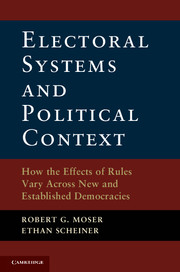43 results
Contributors
-
-
- Book:
- The Cambridge Dictionary of Philosophy
- Published online:
- 05 August 2015
- Print publication:
- 27 April 2015, pp ix-xxx
-
- Chapter
- Export citation
Between Science and Engineering: Reflections on the APSA Presidential Task Force on Political Science, Electoral Rules, and Democratic Governance: Electoral Rules and Political Inclusion
-
- Journal:
- Perspectives on Politics / Volume 11 / Issue 3 / September 2013
- Published online by Cambridge University Press:
- 18 September 2013, pp. 814-818
- Print publication:
- September 2013
-
- Article
- Export citation

Electoral Systems and Political Context
- How the Effects of Rules Vary Across New and Established Democracies
-
- Published online:
- 05 November 2012
- Print publication:
- 28 September 2012
8 - How Political Context Shapes the Effect of Electoral Rules on Women's Representation
-
- Book:
- Electoral Systems and Political Context
- Published online:
- 05 November 2012
- Print publication:
- 28 September 2012, pp 208-235
-
- Chapter
- Export citation
2 - Mixed-Member Electoral Systems
-
- Book:
- Electoral Systems and Political Context
- Published online:
- 05 November 2012
- Print publication:
- 28 September 2012, pp 42-69
-
- Chapter
- Export citation
Tables and Figures
-
- Book:
- Electoral Systems and Political Context
- Published online:
- 05 November 2012
- Print publication:
- 28 September 2012, pp ix-xii
-
- Chapter
- Export citation
Introduction
-
- Book:
- Electoral Systems and Political Context
- Published online:
- 05 November 2012
- Print publication:
- 28 September 2012, pp 1-12
-
- Chapter
- Export citation
Index
-
- Book:
- Electoral Systems and Political Context
- Published online:
- 05 November 2012
- Print publication:
- 28 September 2012, pp 273-284
-
- Chapter
- Export citation
3 - How Democratic Experience and Party System Development Condition the Effects of Electoral Rules on Disproportionality and the Number of Parties
-
- Book:
- Electoral Systems and Political Context
- Published online:
- 05 November 2012
- Print publication:
- 28 September 2012, pp 70-88
-
- Chapter
- Export citation
7 - Social Diversity, Electoral Rules, and the Number of Parties
-
- Book:
- Electoral Systems and Political Context
- Published online:
- 05 November 2012
- Print publication:
- 28 September 2012, pp 180-207
-
- Chapter
- Export citation
Glossary of Key Terms
-
- Book:
- Electoral Systems and Political Context
- Published online:
- 05 November 2012
- Print publication:
- 28 September 2012, pp xv-xx
-
- Chapter
- Export citation
References
-
- Book:
- Electoral Systems and Political Context
- Published online:
- 05 November 2012
- Print publication:
- 28 September 2012, pp 259-272
-
- Chapter
- Export citation
6 - How Democratic Experience and Party System Development Condition the Effect of Electoral Rules on Strategic Defection
-
- Book:
- Electoral Systems and Political Context
- Published online:
- 05 November 2012
- Print publication:
- 28 September 2012, pp 149-179
-
- Chapter
- Export citation
Contents
-
- Book:
- Electoral Systems and Political Context
- Published online:
- 05 November 2012
- Print publication:
- 28 September 2012, pp vii-viii
-
- Chapter
- Export citation
4 - How Democratic Experience and Party System Development Condition the Effects of Electoral Rules on Disproportionality and the Number of Parties
-
- Book:
- Electoral Systems and Political Context
- Published online:
- 05 November 2012
- Print publication:
- 28 September 2012, pp 89-120
-
- Chapter
- Export citation
Frontmatter
-
- Book:
- Electoral Systems and Political Context
- Published online:
- 05 November 2012
- Print publication:
- 28 September 2012, pp i-vi
-
- Chapter
- Export citation
9 - Conclusion
-
- Book:
- Electoral Systems and Political Context
- Published online:
- 05 November 2012
- Print publication:
- 28 September 2012, pp 236-258
-
- Chapter
- Export citation
5 - Political Context, Electoral Rules, and Their Effects on Strategic and Personal Voting
-
- Book:
- Electoral Systems and Political Context
- Published online:
- 05 November 2012
- Print publication:
- 28 September 2012, pp 121-148
-
- Chapter
- Export citation
Abbreviations
-
- Book:
- Electoral Systems and Political Context
- Published online:
- 05 November 2012
- Print publication:
- 28 September 2012, pp xiii-xiv
-
- Chapter
- Export citation
Acknowledgments and Note on the Online Appendix
-
- Book:
- Electoral Systems and Political Context
- Published online:
- 05 November 2012
- Print publication:
- 28 September 2012, pp xxi-xxiv
-
- Chapter
- Export citation

